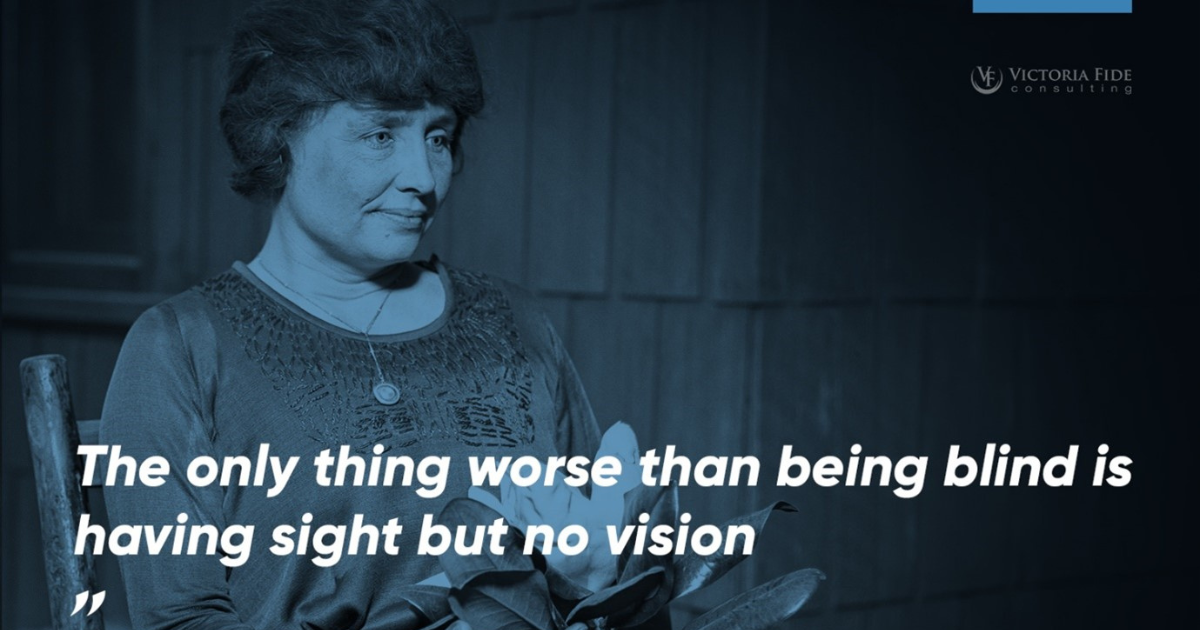
The Sage Wisdom series is produced by Victoria Fide Marketing with input and oversight from our leadership team and industry SMEs.
Helen Keller, a remarkable American author, lecturer, and advocate, overcame profound challenges after losing her sight and hearing in childhood due to illness. With the help of her teacher, Anne Sullivan, Keller learned to read and write, and eventually became the first deaf-blind person to earn a bachelor’s degree from Radcliffe College. Her life serves as an inspirational example of resilience, hope, and determination. Keller went on to become a prolific author and advocate, significantly impacting the lives of people with disabilities and promoting awareness and accessibility.
Helen Keller once said, “The only thing worse than being blind is having sight but no vision.” This profound truth is applicable when undertaking a digital transformation. Rushing through the preparation phase and proceeding without a well-defined vision can lead to wasted resources, ineffective decision-making, and missed opportunities, ultimately hindering the organization’s ability to thrive.
This article examines the importance of having a clearly-defined vision, and the role of proper preparation in aligning the transformational technology initiative with the organization’s strategic vision. We will discuss how Victoria Fide’s Process for Transformational Change uses preparation to ensure a successful and sustainable transformation journey.
Vision: The Foundation for Preparation
In the realm of digital transformation, having a clearly defined vision is paramount. This vision for the transformational initiative serves as the foundational framework for decision-making and strategic planning, much like the guiding light of the North Star. Undertaking a significant transformation without a clear vision is like trying to navigate a ship through dangerous waters without navigational equipment.
Although many leaders acknowledge the importance of having a vision, what may not be immediately apparent is the significant role that vision plays in preparedness. Vision needs to be defined before activities such as creating a budget, writing a charter, or creating a project plan can be executed. While leaders may have a general goal or desire for a digital transformation, a proper vision requires detailing how the organization will look and operate once the initiatives are completed.

Free PDF Download
In the rapidly changing digital landscape, more and more companies are desperately trying to keep up with the competition. Download “The 10 Biggest Mistakes Businesses Make in Digital Transformation” for free today to learn how to use DX to radically transform your business and gain an edge over your competitors.
Once the vision is appropriately defined, adequate preparation ensures that the path to realizing this vision is unobstructed and logically structured. While vision provides the organization with the necessary insight to ascertain where it desires to be, preparation provides the plan on how to meticulously navigate the transformation journey in order to get there.
Preparation and the Pitfalls of Neglect
It is imperative to establish a clear understanding of what constitutes effective preparation. The initial phase of Victoria Fide’s Process for Transformational Change is Prepare, which serves as the cornerstone for a successful transformational journey. The Prepare phase is further broken down into four steps: Discover, Define, Build, and Enable, which lay the groundwork for all subsequent actions and decisions.
Rushing into digital initiatives without carefully completing the steps in this preparatory phase can result in misaligned objectives, squandering valuable resources, and fragmented efforts. The absence of a well-defined roadmap often leads to confusion and inefficiencies.
Process for Transformational Change: Prepare
Effective preparation encompasses a comprehensive assessment of an organization’s existing state, the identification of transformational opportunities and constraints, the formulation of precise objectives, and the development of a well-structured strategy. It encompasses an analysis of technology requirements, resource allocation, and a delineation of roles and responsibilities.

Transformation is not easy, but it doesn’t have to be impossible. Take control of your project’s success today and schedule a free 30-minute consultation to find out how Victoria Fide can equip you for transformational success.
Let’s examine the four steps of the Prepare phase in greater detail.
Discover Opportunities and Obstacles
The initial step, Discover, is foundational to the entire process. During the Discover step, organizations must examine their current state, striving for a comprehensive understanding of their operations, systems, and processes. The objective is to unearth opportunities ripe for transformation and to identify any prevailing obstacles that may hinder progress.
This step involves scrutinizing existing practices, engaging stakeholders at various levels, and leveraging data analytics to pinpoint areas where digital enhancements can yield substantial benefits. Simultaneously, it necessitates recognizing any entrenched barriers, whether they are cultural, procedural, or technical, that may impede the smooth execution of transformational initiatives.
In essence, the Discover step is akin to conducting a thorough diagnostic assessment of the organization’s digital landscape. It sets the stage for informed decision-making and lays the groundwork for strategic planning, ensuring that the subsequent stages of digital transformation are built upon a solid foundation of knowledge and insight.
Define the Vision
In the Define step, organizations will analyze the information gained from the Discover step to provide a clear vision for a transformed organization, the business justification for making those changes, and a clear path for obtaining that transformation.
The importance of establishing a specific end goal for the digital initiative cannot be overstated. This end goal should provide a clear depiction of the company’s envisioned state and behavior once the planned initiatives have been successfully executed. It serves not only as the criteria for success but also as a visionary blueprint for the business to fully enjoy the rewards of their successful completion. It is this vision that will guide every decision throughout the project’s lifecycle, echoing Keller’s compelling insights.
To achieve the defined vision, it will be necessary to set clear and precise success criteria that directly measure against the desired business outcomes. These criteria should encompass both high-level and low-level objectives, enabling a shared understanding of what needs to be achieved in order to realize the intended results.
Build the Transformation Team
Building the right team for your digital transformation can prove to be more challenging than expected. When the team comprises the organization’s top talent, the daily operations could potentially experience disruptions, or it could lead to employee burnout. It’s also critical to weigh the experiences, skillsets, and personality of each team member to ensure each of them are qualified and confident in their role on the transformation team while playing a positive role in the team’s culture.
Ideally, the team responsible for driving transformation should be a carefully selected blend of existing talent and external expertise. Your existing talent pool possesses invaluable institutional knowledge and an understanding of the organization’s culture, which can facilitate a smoother transition. However, in addition to filling potential skills gaps and labor shortages, external consultants experienced with digital transformations bring fresh perspectives, specialized skills, and an objective viewpoint that can be instrumental in navigating the complexities of digital transformation.
Ultimately, the key lies in harmonizing the strengths of your internal team with the insights and capabilities of external experts. Achieving this equilibrium ensures that your transformation endeavors are grounded in both institutional knowledge and transformational experience, providing a robust foundation for success in your digital initiative while enabling your organization to continue its day-to-day operations.
Enable Change by Setting Expectations and Removing Barriers
The final step in the Prepare phase is to enable the change by setting clear expectations and removing barriers. This step is instrumental in ensuring a smooth transition and aligning efforts with the established vision.
Communicating expectations helps clarify resource allocation and time management for the transformation team. This includes setting clear roles and laying expectations for handling day-to-day operations alongside the digital initiative, and possibly backfilling with augmentation to help support current employees.
Defining clear and well-communicated project governance expectations is essential for successful project management and alignment with organizational goals. These expectations set the tone for the entire project and encompass various aspects of project management such as scope, schedule, budget, risk, and governance structures. Documenting and communicating project governance expectations ensures all team members are on the same page and can function effectively toward the shared goal.
Removing barriers may include providing the necessary resources, training, and support for employees. Adequate training programs equip personnel with the skills and knowledge required to execute on the digital transformational roadmap. Furthermore, the provision of ongoing support fosters confidence and competence among team members.
Finally, garnering buy-in from the team and stakeholders is indispensable. When individuals at all levels of the organization understand and embrace the vision, they become active participants in the transformation journey. Their commitment and alignment with the overarching goals significantly contribute to the success of the initiative.

Vision and Preparation as Guiding Principles
Helen Keller’s quote, “The only thing worse than being blind is having sight but no vision,” drives home the critical need for vision within the context of digital transformation. A clearly defined vision renders preparatory activities effective by keeping the team, scope, requirements, and resources aligned on the shared goal, enabling the organization to achieve transformational success in this dynamic landscape.
We strongly emphasize the need for organizations to adopt a thoughtful and strategic approach to digital initiatives. Preparation is not merely setting a budget, writing a charter, or creating a project plan, but an integral phase of the project that discovers opportunities, defines the vision, builds a powerful transformation team and enables them to achieve lasting success. By embracing each step of the Prepare phase, organizations can navigate the complexities of digital transformation with confidence, ultimately thriving in the ever-evolving digital age.
Subscribe to our weekly LinkedIn Digital Transformation Success newsletter and get notified of each new edition.
